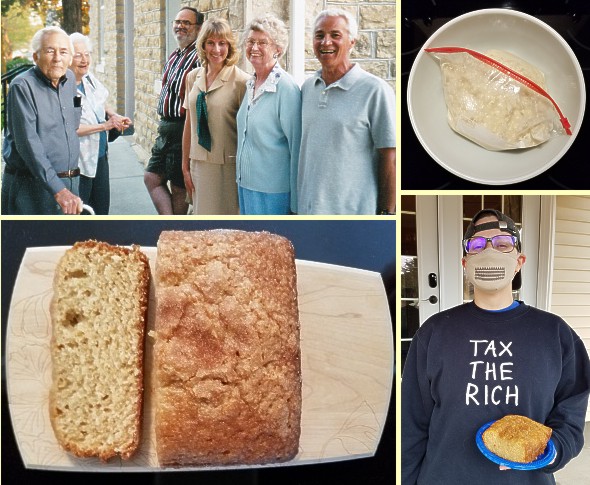Kansas Snapshots by Gloria Freeland - April 2, 2021
A gift that keeps on giving
With wine and cheese, greater age is usually considered a good thing, but for most other foods, old is bad. So when I say
I'm going to serve something I whipped up from ingredients 20 years old, I could understand folks being a bit reluctant
to dig in.
Until they try it!
My neighbor Jeanie gave me a bag of "starter" and a recipe around Christmas 2001. It was to make something called Amish
Friendship Bread. Dolly Parton once said, "I'm not offended by all the dumb blonde jokes because I know I'm not dumb...
and I also know that I'm not blonde." The bread is a bit like that. It has absolutely nothing to do with the Amish. And the
friendship part? I consider Jeanie a friend, but at first it seemed like something you might give to your enemy.
Unless you raise your own wheat, bread making is a few hour affair - except for this version. You begin with the starter in
a Ziploc bag, periodically adding flour, sugar and milk over a 10-day period. "Mushing" it - a technical term for flexing
the bag to mix the ingredients - is also required during the process.
I followed the directions, froze four out of the five cups it generated, and made two loaves of bread out of the fifth cup.
Now anyone who knows me well will testify that I love a warm cinnamon roll slathered with frosting and a pat of butter. But
that bread, with its sugary-cinnamon taste, provides serious competition. My apologies for doubting you, Jeanie!
I am not much of a baker, but I have no idea how many loaves I've made over the past two decades. It must be in the hundreds.
I've given most of them away - that's where the friendship part of the name comes from. I've made it for my folks, for Art's
mom Donna and his brother Tommy, and to neighbors Tom and Aaron as a "thank you" for plowing the snow off our driveway. I've
also taken them to holiday gatherings at work and given small loaves as Christmas gifts.
Donna liked the bread so much that though she would occasionally share a slice with Tommy, she usually hid it when he was
coming over. She mentioned how she never let herself eat more than one slice a day and cut it thin to make it last as long
as possible.
After she died, Tommy commented that he liked my bread more than Donna's banana bread. Until his death in January, I sent
him a loaf every two or three months.
I also sent a loaf in an early Easter package to college friend Deb, who said, "Love your bread! Such great texture ...
light and so consistent. And I love the crunchy outside. How do you do that? I will be in trouble if I leave it sitting out.
I may freeze some of it."
Not long ago, I sent a loaf westward to my brother Dave, and another eastward to my sister Gaila. Dave's daughter-in-law
Kristina texted me.
I was glad they enjoyed it, but the starter is really quite easy to keep going. I mentioned I've had mine since Jeanie gave
it to me 15+ years ago and I'd give her a bag when I saw her again.
She replied, "What???? 15 years ago??? Do you make it once a week??"
I laughed. That would be way too much like work. I explained that I make five bags from one bag of starter. It's an 11-day
process where I just let it sit most days and add sugar, flour and milk other days. Then I can freeze four bags and use
one to make two loaves of bread, or just freeze all five if I am too busy to bake.
I laughed again when she replied, "Oh!! I was thinking you have just been making bread for 15 years non-stop!"
So what is the deal with using part of a previous batch to make the next one? A glance at the ingredients reveals one element
that is missing typically seen in breads - there is nothing to make the bread rise! While yeast is recommended for the starter,
it is not essential, serving only to "prime the pump." The dough relies on the same thing wine making depends on. The yeasts
that are everywhere - on our foods and even in the air - begin fermenting the carbohydrates and sugar in the mixture. This
generates carbon dioxide, which causes the bread to rise, plus alcohol and other flavoring elements. The baking process stops
the fermentation and drives off the alcohol.
The flavoring elements are what adds something special to the taste of the bread. So I wasn't surprised when after tasting the
loaf I sent to my sister, her daughter Larisa texted, "Would you give me the friendship bread recipe if I asked or too secret?"
It's no secret and now she's an Amish Friendship Bread devotee as well, making it for her dad's February birthday and
Valentine's Day.
And daughter Mariya's friend Josh recently asked for a starter, so now the bread has broken the family boundary.
Jeanie moved some years ago and now lives in Texas. But her Amish Friendship Bread? Well, that's a gift that just keeps on
giving!
